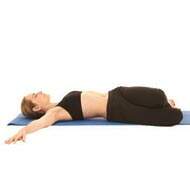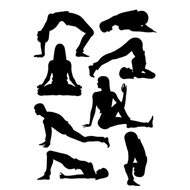Applications Of Revolved Abdomen Pose & Precautions
Revolved Abdomen Pose (Jathara Parivartanasana) is performed in the supine position and helps stretch the hips and spine while toning the belly.
Performing twists are beneficial for the detoxification of the body and decompression of the spine.
Performing the pose after a long day at work can help you get rid of emotional fatigue and bring balance to your mind and body. The Sanskrit term for this pose, ‘Jathara Parivartanasana’ is derived from three words. ‘Jathara’ means ‘belly’ or ‘abdomen’, ‘Parivarta’ means ‘revolved’ and ‘Asana’ means ‘pose’. Other names for this pose include ‘Reclined Straight-Leg Twist and ‘Belly-Revolving Pose’.
Steps :
- Begin in the supine position with your knees bent and your feet kept flat on the ground. You can keep your head on a blanket or pillow to support your neck.
- While breathing out, bring your knees to your chest and let your hands wrap around them.
- Let your arms extend out along the ground at the height of your shoulders with your palms facing the ground. Make your legs straight so that they come toward the ceiling. Be sure that your back is flat on the ground.
- While breathing out bring your legs down to your left and allow your right hip to come off the ground. Allow the gravitational force to pull your legs all the way down. Your left leg should rest on the ground. The outer part of your right ankle should rest on top of your left ankle.
- Try to bring your legs and torso to a 90-degree angle. If your legs are angled toward your left shoulder you can hold your left foot’s toe with the fingers of your right hand.
- Let your head turn to the right and softly gaze at the fingertips of your right hand. Remain in this pose for around 10–25 breaths.
- While breathing in, slowly get back to the center position and raise your feet to the ceiling. Then bend your knees and hold onto them towards your chest. While breathing out bring your heels to the ceiling again and repeat the steps on the other side.
- Once you’re done with the pose, hold your knees to your chest for a few breaths and slowly breathe out while extending both legs along the ground.
Precautions :
- Approach this posture cautiously if you have back injuries, back pain, or degenerative disk disease. You should attempt this posture only under the guidance of a knowledgeable and experienced instructor.
- Avoid practicing this pose if you have a chronic or recent injury to your hips or knees. Always work within the range of your own abilities and limits.
- If you suffer from any medical problems, you should consult your doctor before attempting this pose.
Beginner’s Tip :
Your breathing during the performance of the pose should be deep and smooth. Make sure that breathing is steady while performing the pose.
You can also use props like pillows or blocks to prevent injury from putting in too much effort in twisting and also to give support when the legs, arms or shoulders cannot rest easily on the floor. You should never bring your knees to the floor with force. Concentrate on keeping the shoulders on the ground. Your shoulders should also be kept relaxed and away from your ears. Always be aware of how your back feels while performing this pose. If you experience any jarring, pinching or sharp pain stop the pose immediately by slowly getting out of it. If you are in pain, you should never twist with force. At times the shoulder on one side of the body gets lifted during the twist. This means that you have gone beyond the proper way to do it. Relax a little and make sure your shoulders are grounded equally.
Benefit To Body Part :
- The back gets strengthened along with the spine and all the muscles of the abdomen, especially the obliques.
- It eases stiffness and increases flexibility in the shoulders, chest, hips, lower back and spine.
- The pose helps in proper digestion.
- Blood circulation throughout the body improves.
- The compression of the organs that is caused with this pose releases metabolic waste and toxins. The organs also get fresh oxygenated blood.
- There are many benefits to twisting the spine. When the spine twists and stretches not only will the spinal discs be hydrated but it will also realign, relax and lengthen the spine.
Therapeutic Applications :
- Stress and anxiety: It is said that practicing this pose is good for relieving stress and anxiety. It is often prescribed to those suffering from depression and insomnia.
- Fatigue: The pose is not only relaxing but also re-energizing. As such, it has been known to be effective for those who feel tired all the time.
- Headaches: The revolved abdomen pose is also good for those suffering from migraines and headaches.
Variations :
- For a mild variation, you could let both the knees remain bent throughout the entire pose.
- If your knees tend to rub each other you could keep a blanket that is folded between your legs.
- If your bottom foot does not come in contact with the ground, you could allow it to rest on a folded blanket, block or bolster.
- For a bigger challenge, rather than bringing your bottom foot completely down to the floor, let your feet remain in the air an inch or two above the floor.
Performing the Revolved Abdomen Pose is an excellent way to realign and lengthen your spine while strengthening the area of your abdomen. Including this pose to your daily routine can enable your mind and body to release toxins and tension and can make you feel refreshed and rebalanced all through the day.



